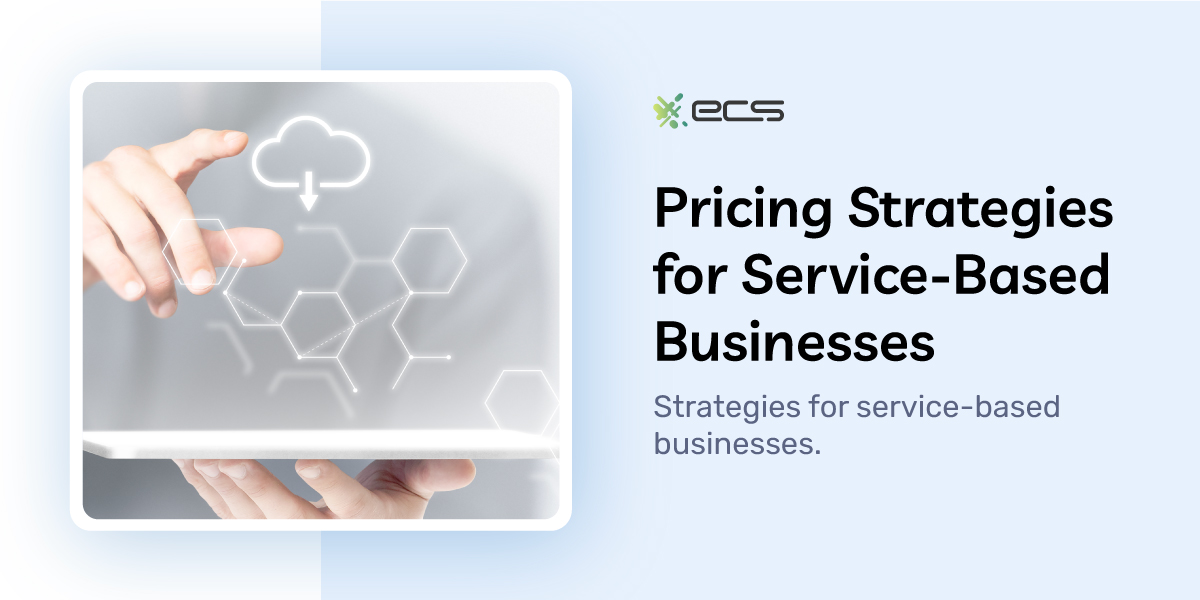Considering all the work that goes into opening and managing a business, you would think pricing your services would be one of the more manageable tasks. However, that couldn’t be farther from the truth. Many service-based businesses struggle with how to price their services. Strategies for Service-Based Businesses, unlike retail-based ones, involve a more complex evaluation of factors.
With a retail-based business, pricing can be much more straightforward. Each item generally has a fixed cost, especially if you don’t produce the product yourself. This means you can more easily determine your profit margins on each product sold. From there, it’s just a matter of breaking up your overhead costs and other expenses to determine your net profits.
Service industries are entirely different, however. Businesses may offer different levels of service. Each service offered may also involve more nebulous costs, such as material or transportation costs going to and from the job.
All of these variables make determining the right price point difficult. The problem is that if you choose the wrong pricing structure, you could be harming your business. You’ll quickly start burning through your capital if the price is too low. You won’t convert any leads into paying clients if you charge too much.
So, how do you find the sweet spot?
Below, we’ll cover the most common pricing strategies for service-based businesses that have been proven successful to set prices. Armed with this information, you should have more insight on how to set your prices and keep your business growing.
What Are Service Pricing Strategies?
A pricing strategy is a business’s informed process or methodology to set prices. The purpose of the strategy is to consider several factors and then develop a pricing structure that meets the needs of the business and the customer.
A sound pricing strategy will always consider the costs of providing the service. But it should also integrate market conditions, competitors, competitive advantages, local market sentiments, regional cost of living adjustments, and many other factors.
If a business fails to consider or omits any factor in the pricing strategy, it risks pricing its service too low or too high, which can hamper growth.

Benefits Of Using the Right Pricing Strategy
When consumers make purchasing decisions, pricing is one of the top factors they consider. This means that if a business chooses the wrong pricing strategy, it puts itself in an unfavorable position when attracting new customers.
Below are some other benefits of setting the correct prices for your service.
More Growth Potential
Consumers will see your service as a value with the right pricing strategy. This means you have the possibility of attracting the largest amount of market share.
Growth for a business comes from either increasing market share or increasing revenue. Pricing is at the heart of both of these mechanisms. If your pricing structure is not right, you will have difficulty growing your business. This is true even if every other aspect of your business plan is on point.
Solidifies Your Place In The Market
Every successful business operates in a specific tier within a given market. For example, some businesses may focus on budget-focused customers. At the same time, other businesses may focus on the high-end or luxury portion of a market.
Your pricing structure plays a significant role in how you solidify your place in the marketplace. It also prevents your business from trying to compete for clients where you don’t have an advantage.
For example, a budget-friendly brand should not waste resources to secure consumers looking for a higher-priced product or service.
The correct pricing of your service allows you to focus all of your marketing resources on potential consumers who are most interested in your service and price point.
Gives You A Competitive Advantage
Tailoring your pricing perfectly for your target market gives you an immediate advantage over competitors who do not use the correct pricing. Specific pricing strategies for service-based businesses can also help you gain a price advantage in certain circumstances.
For example, when breaking into a new market, you may be able to use various pricing strategies to help you penetrate it.
Careful consideration is necessary for market penetration-style pricing strategies. You will have to raise your prices if you cannot sustain your initial lower prices. These wild price fluctuations can harm your brand image and erode consumer confidence.
This is one of the reasons that pricing too low can often present more possible downside risks than pricing too high.
The Top Service-Based Business Pricing Strategies
Now that we’ve outlined the importance of pricing strategies for service-based businesses and their benefits, it’s time to dive into the most common pricing models for service-oriented businesses. Each of these will have its own use case and benefits. The trick is determining which matches your brand, market, and business goals the best.
Market Penetration Pricing
Market penetration pricing is probably the most common strategy for business owners to consider when entering a new market.
Penetration pricing is when you intentionally set your prices below the competition to quickly gain market share. Over the long term, you will slowly raise your prices or reduce discounts to compensate for the lost revenue from the penetration pricing.
The bottom line is that this can work for certain services where the target audience is price-sensitive regarding goods and services. However, this type of pricing does provide significant downside risks.
If you can’t sustain the low prices long enough to gain market share, you risk running out of operating capital. Another common risk is that established competitors may be able to match your lower pricing. Since they are more established, they can sustain the lower prices for longer.
The key to making this strategy successful is careful budget control and efficiency within your business. In addition, you want a detailed plan for how you will raise prices and increase your profit margins. The competitive landscape in service industries can make penetration pricing common, but just be aware of the downsides.
However, penetration pricing is still a viable strategy despite the downside risks.


Value-Based Pricing For Services
A business sets prices based on the consumer’s perceived value of the service in value-based pricing. This pricing model offers a good deal of flexibility and focuses on intangible service pricing. In general, value-based pricing can lead to higher price points.
This method is best if you offer a unique service. For example, a home cleaning business may use only organic and non-chemical products. Customers who want this service will perceive it to have a higher value than a typical cleaning service.
You can quantify how much the organic cleaning supplies cost, but the value to the customer is a different matter. In this scenario, the customer will value the health benefits of the organic products higher than their actual costs.
This means you can charge higher prices and enjoy higher margins.
For this strategy to work, you need to offer something unique with a value that is difficult for consumers to quantify in dollars and cents. Also, your brand image and marketing must match the luxury or high-end experience your pricing promises.
Price Skimming
Price Skimming is essentially the opposite of penetration pricing. Price skimming involves setting the highest possible price consumers will pay and slowly lowering it over time. This strategy works well if you are first to market with your service. However, this strategy generally won’t work well when entering a market with other established competitors.
Price skimming is sometimes combined with location-specific pricing strategies for service-based businesses if your service is new to locations that you expand into.
Premium Pricing
Premium pricing is when you price your service higher than the competition but for different reasons than price skimming or value-based pricing. With premium pricing, you are offering a tangible upgrade in service in exchange for the higher price you are charging.
For example, if your company does home remodeling, you may offer extended warranties, upgrades, or other additional services that other remodelers don’t.
The key to making premium pricing work for your company is ensuring you effectively communicate the value of your extra offerings. If you are selling in person, your salespeople must communicate the benefits of your additional services.
Regarding marketing strategies, you must also heavily promote this aspect of your business; otherwise, potential customers may simply think you are more expensive.
Competitor Based Pricing
Competitor-based pricing strategy is probably the easiest way to set your pricing, but it also doesn’t offer many benefits. For this strategy, you will analyze your competitors and set your prices similarly to theirs. From there, you adjust your business operations to ensure a profit margin that can sustain the business.
This pricing strategy is necessary for specific service industries because consumers expect a certain price for the service. In cases like this, you don’t have a lot of room to adjust prices and have to find another way to differentiate yourself or add value.
Bundling And Upselling
Bundle pricing is when you break up your service options and then, during the sales process, offer to combine similar products or services for extra savings. This is a form of upselling where you get the customer to spend more than they initially intended by offering them a revised deal or suggested option.
One advantage you have with bundling is that it allows you to combine different pricing models and strategies at the same time.
For example, you can offer a very basic bundle at a lower price, similar to penetration pricing, to attract new customers. But once acquired, you can offer them a more expensive bundle with added options and services.
The key to making this strategy work is to carefully create your different bundled options so that the bundling creates a real value proposition for the customer.
If you simply add random services to the bundle to raise the price, the customer won’t see any value in it.
Tiered Pricing
Tiered pricing is when you offer different service levels at various price points. This is similar to bundling but with a few key differences.
In marketing, professionals generally term this pricing strategy as “good, better, best” pricing or GBB. With GBB, you set up three options for your service. Each one is more expensive than the previous one and also offers more service options.
Creating a “fence” between your different pricing categories is key to making this system work. A fence is an addition or removal of a service option to dissuade customers from moving down to a lower tier. In addition, you need to provide clear incentives for people to move up to a more expensive tier.
You’ve likely come across GBB pricing models while shopping for various services. You may have also noticed that the seller will generally promote the middle option as the “most popular” or best value. This is a classic example of trying to get the customer to move up to a higher-priced tier to maximize profits.
Successful service price case studies have shown that recurring services billed on a monthly basis benefit most from GBB pricing.
This strategy can still work for one-time services, but creating effective fences to stop customers from going with the lowest-cost option is generally more challenging.

Hourly Pricing
Hourly pricing is relatively straightforward for most businesses. You simply set an hourly rate for your service and bill customers accordingly. This can work if the service you provide is identical across most situations.
For example, a car mechanic can charge an hourly rate because their work for different repairs is very similar. Some just take longer than others. Hourly pricing doesn’t work well where there are many variables within your service. It also doesn’t work well if you have supplies and materials that are specific to each job.
For highly specialized services, there is a question of hourly rates vs. value-based pricing and which is better. Generally, hourly pricing is better if you are a single person providing the service. For larger businesses, value pricing will yield better results.
Project Pricing
Project pricing is most common in the construction business but works in other professional service industries like cybersecurity. With project pricing, you estimate the cost of the job based on the specifics and then present the estimate to the customer.
This pricing allows you to be flexible with your pricing. However, it would help if you created very accurate estimates. With project pricing, you’ll also need to keep tabs on the project as it progresses to ensure you don’t go over budget and lose money.
Competitive Analysis In Service Pricing
Even if you choose not to use competitor-based pricing methods, you will still want to analyze your competitors. This will help you gain insight into your local market and also help you find areas where you can earn a competitive edge.
Below are the steps needed to perform a competitor analysis.
Identify Your Competitors
Identifying your competitors is the first step when analyzing competitor pricing. You want to list competitors that most closely match your service. If you already understand your local market, you may want to focus on the competitors you want to take customers from.
If you’re a new service-based business just starting, you will want a more general list of all your competitors.
One thing to avoid when performing competitor analysis is choosing competitors that aren’t direct competitors. Some companies may provide similar services to yours as an addition to their primary service. You generally want to avoid including companies like that in your analysis, as it will skew the data.
Gather The Pricing Data
Gathering pricing data can be difficult, depending on your specific industry. If your competitors list their pricing, then this process is relatively easy. You can generally just visit their website or call to find out their pricing structure.
Other businesses may not list their prices and require a consultation or visit with a sales representative. This can make the process more difficult.
However, you can still generally find out their pricing structure. One method is to seek out reviews or past customers. Reviews and other comments can give you insight into whether the company uses hourly rates or bundles various services.
If you’re an established business, you may want to ask your current or potential customers if they have interacted with your competitors. If so, you can ask about the pricing.
For service providers that cover more than one location, there may be a geographical impact on service pricing to consider during this process. Competitors may charge different rates in different areas, implementing regional cost of living adjustments.
Finally, don’t be afraid to get creative. Try posting on local neighborhood forums or professional forums related to the service. You can ask if anyone has had experience with a specific company and then ask about their pricing.
Sometimes, the process of gathering pricing information can require a little leg work, but it’s well worth the effort when it comes to optimizing your own pricing.
Compare Pricing
At this point, you should have a good amount of data to work with. So, the task now is to analyze the different competitor price points and pricing strategies for service-based businesses. Match up the different price points and strategies based on competitor size and dominance. This will give you insight into the most common pricing structure and what consumers expect.
Next, you want to use this data to find openings or gaps in the market. For example, is your local market missing a premium or budget provider? Your competitor pricing analysis should be used to look for opportunities like this as well as simply to determine your own pricing.
After an analysis, you may find you should change your original pricing structure to take advantage of market openings left by competitors.
Dealing With Hidden Expenses In Service Pricing
When businesses sell a product, they use a metric called the cost of goods sold (COGS). This calculation includes the direct costs of materials and other product creation expenses.
There are still direct and indirect costs in service business pricing, but it’s harder to calculate the cost of delivering a service. Part of the reason is that service businesses can have more hidden costs.
Hidden or hard-to-calculate costs can be things like the software used to run the business. This software usually involves a lease or ongoing charges. Other costs like transportation, internal shipping costs, or meetings with customers can often be more challenging to incorporate into your calculations.
The first step when dealing with hidden costs is first to identify them. An audit can work well to identify hidden costs. You will also want to audit past jobs you’ve done for customers and look for hidden expenses within the job. For example, did you hold several meetings with a customer who was not billed?
If so, these additional meetings are a hidden cost. To address this, you can consider adding a fee for these consultations or possibly raising your overall prices.
Another option is to find ways to eliminate the need for the hidden expense. In the previous example of meetings with the customer, perhaps you can find a way to minimize these in the first place.
One method may be keeping your customers informed about their service via automated messages or a client dashboard on your website.
Marketing Costs
Marketing expenses can be another source of hidden costs for a small business or service-based business. If you don’t closely monitor your marketing metrics, your campaigns can become unprofitable. This is common if your marketing efforts are primarily on autopilot.
For example, if you make the same ad buys week after week. These efforts may lose effectiveness over time and become a hidden expense. To avoid this, audit your marketing efforts regularly to ensure they return a positive ROI.
Overall, there can be many hidden costs within a business, which can vary depending on your industry. The key to avoiding these expenses is through careful auditing of both your ongoing expenses and past projects.

Tips For Choosing The Best Pricing Strategy For Your Service Business
Now that we’ve discussed the different pricing strategies, you’ll want to choose which one fits your business best.
To do this, you’ll want to consider several factors before choosing.
Your Business Expenses
Different businesses will have different expenses. If you’re just starting a business, you may have lower overall costs than an established business. One example is if you run a family business and different family members perform some of your labor.
In these cases, you can opt for penetration pricing to take advantage of your overall lower expenses.
However, a different example is that you have incurred debt to get your business started. In this case, you may have high monthly payments that you need to make. For this situation, you may opt for something that yields higher margins, like price skimming or premium pricing.
Set Your Business Goals
You’ll also want to consider your business goals and what your timeline is for those goals. Every business wants to profit as soon as possible, but some business owners may be able to wait longer before becoming profitable.
How long you can sustain your business while building customers and balancing personal and business expenses will impact which pricing structures you should consider.
Remember that if you use strategies based on lower prices, you must pay especially close attention to your overall expenses to ensure you maintain adequate margins.
Gaining customers at a loss can be a viable option for some businesses. But you will need the finances to maintain those losses until you turn profitable.
Age Of Your Business
Something else to consider is the age of your business and how that ties into your overall plan. Newer businesses can use more novel or aggressive pricing strategies. However, even more established businesses can take advantage of these if they want to reposition the business.
This can be common if new competitors have recently entered your market and stolen market share. When that happens, you can implement a new pricing strategy to better compete in the marketplace.
Strategies For Service-Based Businesses Conclusion
Personalized pricing for entrepreneurs is a tough challenge that many face. Setting the pricing for your service-based business is crucial. The right pricing strategy can help set you up for success and fast growth.
It’s also important to remember that your pricing strategy can’t be developed in isolation. Instead, many other aspects of your business operations will need to complement your strategy.
But with careful research and choosing the proven strategy that works best for your business and your goals, you should be able to grow your service business in almost any competitive environment.
-ECS Payments is an industry-leading payment processor for entrepreneurs in the service industry. Contact ECS Payments to learn more about our innovative solutions designed to give your business the edge.
Frequently Asked Questions About Strategies For Service-Based Businesses
You must consider costs, market conditions, competitors, and more to determine the right pricing structure for your service-based business. To thoroughly understand these considerations, you must conduct a comprehensive analysis and determine which pricing strategy works best for you, such as market penetration, value-based pricing, or tiered pricing. Once you’ve made your determination, ECS Payments can streamline financial transactions to support your chosen pricing strategy.
A thoughtfully calculated pricing strategy attracts customers and fosters growth. It can enhance your market share and position, providing a competitive advantage. ECS Payments can support your growth with customer-tailored payment processing solutions to keep you ahead of your competition.
Conducting a competitor analysis helps you understand market expectations and identify opportunities for your business. You will need to gather pricing information from your competitors and then analyze it to find gaps in the market.
It is crucial to identify hidden expenses so you can properly price your services to make a profit. Conducting thorough audits will help you uncover business costs such as software, transportation, consultations, etc. ECS Payments provides payment processing fee transparency, enabling you to account for those costs in your pricing strategy.
